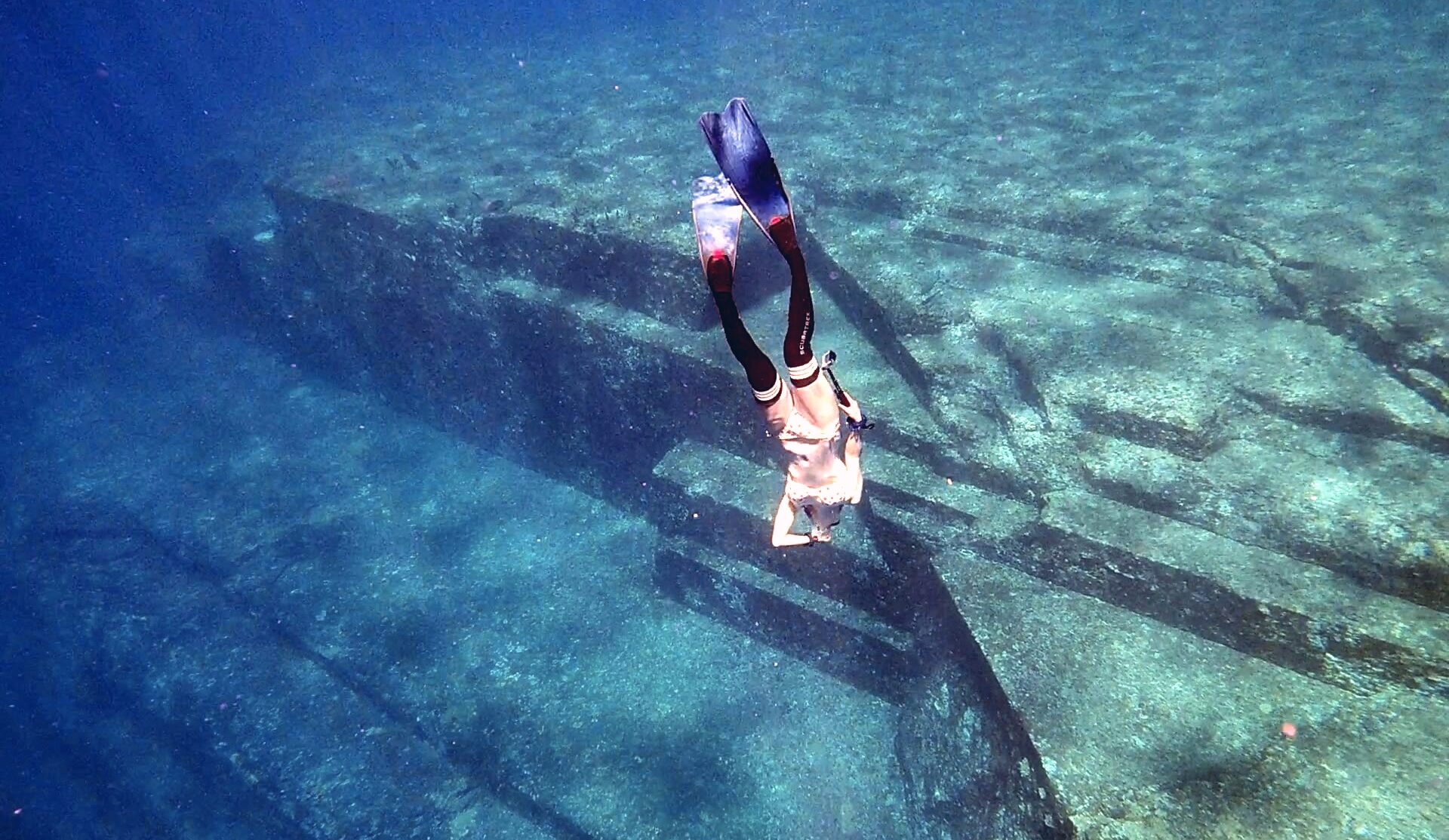Long before Bad Bunny’s “Yonaguni” song came out, Yonaguni Island was already well-known for its Yonaguni Monument. The Yonaguni Monument is Japan’s most famous and popular scuba diving site, its mysterious form often referred to as underwater ruins, the Japanese Atlantis, or Japan’s Underwater Pyramid.
Divers from around the world flock to see this mysterious underwater structure. However, most of the information available online about the Yonaguni Monument in English is inaccurate or misleading. Many websites, even those appearing high in search results, present sensationalized claims without sufficient evidence.
That’s why I’m here to provide you with everything you need to know about the Yonaguni Monument, from its origins to how to plan your visit.
I’ll guide you through the discovery, research, and controversy surrounding the monument. We’ll also cover important facts about planning your visit to this marvelous underwater pyramid in Japan.
Content
- 1 What is the Yonaguni Monument?
- 2 the Yonaguni Monument Location & Origins
- 3 A History of the Yonaguni Monument: A Timeline
- 4 Unraveling the Mystery: Is it Natural or Man-Made?
- 5 The Best Time to Visit the Yonaguni Monument
- 6 Exploring the Monument: Diving and Snorkeling
- 7 How to Plan your visit to the Underwater Ruins in Yonaguni
- 8 Travel Essentials: What to Pack for Yonaguni
- 9 Conclusion
- 10 FAQ about Yonaguni Monument
What is the Yonaguni Monument?
Diving into the waters off Yonaguni Island in Okinawa, Japan, reveals one of the world’s most captivating underwater enigmas—the Yonaguni Monument. This breathtaking site, uncovered in 1986, spans about 250 meters from east to west and 150 meters north to south, rising about 25 meters from the ocean floor. Its striking stone formations evoke the grandeur of an ancient temple, inviting explorers to ponder their origins.
What makes this monument truly fascinating are the terraces, steps, and groove-like channels that hint at possible human intervention. Studies suggest that this structure may have emerged above sea level around 10,000 years ago, adding another layer to its allure. With sharp edges and almost perfect right angles, the formations captivate both divers and historians, fueling debates about whether they are remnants of a lost civilization—perhaps even an “Atlantis” of the East. The monument’s mysterious, temple-like presence continues to spark the imagination, leading to a myriad of interpretations and romantic tales.
Let’s delve into the history of this underwater mystery, exploring its location, discovery, and the controversy surrounding its origins.
the Yonaguni Monument Location & Origins
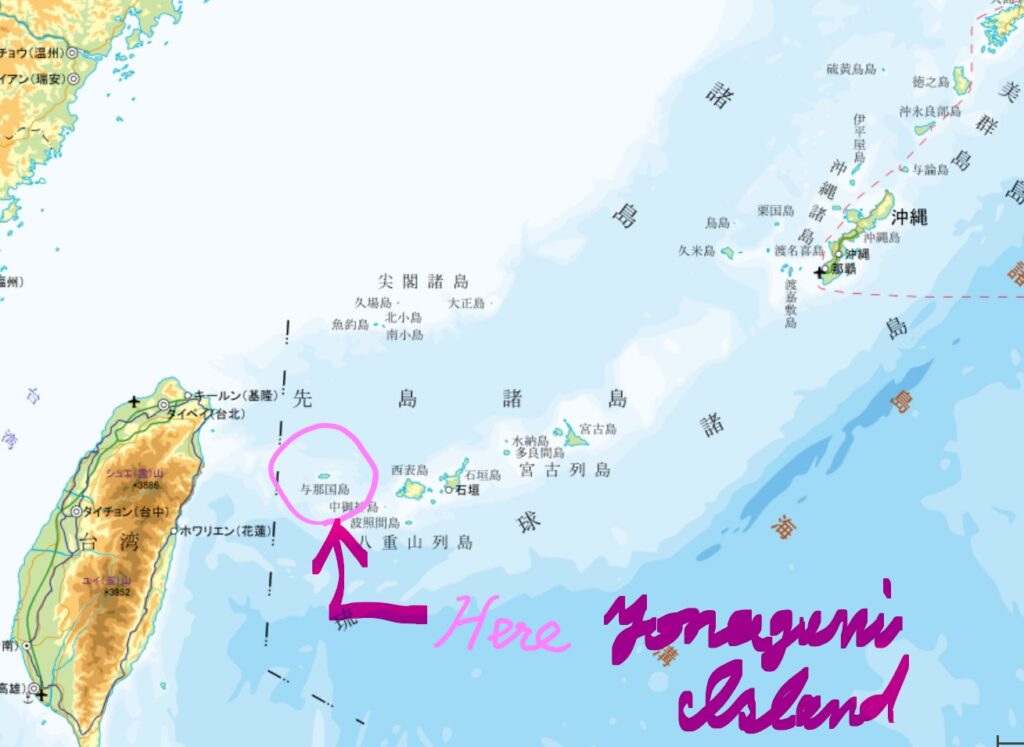
The Yonaguni Monument (Yonaguni Kaitei Iseki) is located off the southeastern coast of Yonaguni Island, the westernmost of the Okinawa Islands in Japan.
Yonaguni Island itself is closer to Taiwan than to the mainland Okinawa, often triggering debate over why Yonaguni was never conquered by Taiwanese. While that is a fascinating topic in itself, let’s focus on breaking down the geographical location of this underwater pyramid.
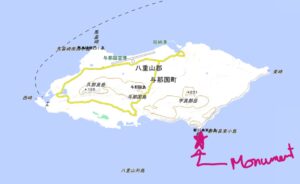
The monument is situated at the southeastern point of the island, as depicted in the map above.
The coastline of the island features cliffs, so the only way to view the underwater formation is by boat. Diving and snorkeling services are available from the western coast of the island at Kubura Port, requiring about a 30-minute boat ride to reach the pyramid location. From the guided boat, you can dive or snorkel down to the monument, which is situated approximately 10 to 20 meters below sea level.
The formation was discovered and named by native diver and diving shop owner Kihachirou Aratake in 1986. His marketing genius led him to name this diving spot the “Yonaguni Underwater Monument,” sparking curiosity among divers and spiritual enthusiasts worldwide. Today, Kihachirou’s son manages the diving shop, Sou Wes, guiding thousands of non-Japanese divers through this mysterious underwater monument. Meanwhile, Kihachirou himself operates a glass boat service from Kubura Port to the Yonaguni Monument, allowing non-water enthusiasts to experience the wonders of the underwater pyramid from above.
A History of the Yonaguni Monument: A Timeline
Just to show easily how the underwater monument drove attention and entertainment development on the island, here is the timeline in table.
| Year | Event Description |
|---|---|
| 1986 | Discovery of underwater formations resembling Inca Ruins |
| 1987 | Initial investigations surrounding the formations begins |
| 1988 | plan/section for the underwater ruins being developed. |
| 1991 | The underwater ruins are broadcasted by NHK. |
| 1994 | A discussion at Tokyo University about the underwater ruins with notable figures. |
| 1995 | Front-page coverage in Ryukyu Shimpō drives media attention; a photo exhibition takes place. |
| 1999 | Symposiums and tours regarding the underwater ruins are organized. |
| 2000 | Tourism resource survey on underwater attractions begins. |
| 2001 | A photo exhibition and lecture are held on a cruise ship. |
| 2002 | Symposium hosted by the Okinawa Convention Bureau. |
| 2003 | Events include a symposium on the Ryukyu Arc and notable media visits. |
| 2004 | Featured in a documentary at Miraikan; ongoing visits from students and researchers. |
| 2005 | Coverage from diving journalists and celebrities. |
| 2006 | Presentation of GPS and GIS findings at a lecture. |
| 2007 | Filming for various documentaries occurs at the ruins. |
| 2008 | Coverage in marine diving magazines. |
| 2010 | Participation in swimming challenges from Taiwan to Yonaguni. |
| 2013 | British television crews film episodes about the underwater ruins. |
The list ends in 2013, but there are numbers of TV segments that covered and continue to cover the topic of Yonaguni’s underwater ruins from time to time. Mysteries in real life always attract people as we know.
But can we break down the mystery about the underwater formations? what does the study say? Here proceeds with the detailed info.
Unraveling the Mystery: Is it Natural or Man-Made?
It remains mystery as to how the Yonaguni Monument was made. Is the rock formation man-made or natural geology?
The Yonaguni Monument features various terraced structures and stepped platforms that resemble ancient architectural characteristics often seen in pyramids, castles, and roads. The entire rectangular rock formation is more than 50 meters long and 20 meters wide, with steps along its side.
While the majority of researchers believe that the monument is a natural rock formation that was submerged by a seismic event or sea level rise around 8,000 years ago, some argue that it is man-made, possibly built by an ancient civilization.
The debate about its origins and whether it is natural or man-made has been ongoing for several decades. It is arguably the most debated underwater archaeological sites in the world.
Let’s look at why some researchers say it is manmade vs natural.
この投稿をInstagramで見る
Underwater Ruins? Why Yonaguni Monument can be Man-made
The debate around the Yonaguni underwater structures centers on specific features that suggest human construction. Proponents argue that natural erosion alone cannot account for the precise shapes and organized layout, giving rise to theories that an ancient civilization once occupied the site. Here’s a breakdown of the arguments and their supporting details. Many claim it to be man-made because 1. that rectangular rock is too long to be naturally formed and 2. It has stair steps.
1. Architectural Features
One main argument is that the formations display architectural traits, such as terraces and flat surfaces with sharp right angles, which resemble early stepped pyramids. Proponents suggest these features show signs of intentional design rather than random erosion. Researchers and divers have documented these flat, consistent angles, which do not typically form under natural erosion
琉球大学地震学研究室 – Ryukyu Seismology Lab
2. Similarity to Known Monuments
The structures’ overall appearance has been compared to ancient monuments, including early temples and pyramidal structures. Those in favor of the man-made hypothesis argue that the arrangement of these features may reflect architectural practices from an ancient culture in the region, though no direct cultural link has yet been proven
琉球大学地震学研究室 – Ryukyu Seismology Lab
3. Purposeful Pathways and Pillars
Distinct paths and upright structures resembling pillars appear in some parts of the formation. Proponents believe these pathways were laid out with purpose, possibly as routes or corridors, and that the upright “pillars” suggest design elements that are too uniform to be formed by geological forces alone. This layout reinforces the argument for intentional human activity
琉球大学地震学研究室 – Ryukyu Seismology Lab
4. Supportive Geological Hypotheses
While most scientists attribute the shapes to coastal erosion, some proponents hypothesize tectonic activity could have uplifted these structures. This theory would allow for the idea that an early civilization built the formations, which were then submerged as sea levels rose and naturally eroded over time
琉球大学地震学研究室 – Ryukyu Seismology Lab
Final Thoughts on Man-Made theory
While the mystery persists, researchers continue to study the Yonaguni underwater formations, which draw global interest for their unique characteristics. Whether a natural wonder or a lost architectural site, Yonaguni remains a captivating subject of exploration.
For further details, see the University of the Ryukyus webpage.
Though there are many theories as to why the Yonaguni Monument could be indeed a ruined monument, there is no firm evidence to back up and historically prove so.
now let’s look at the opposite side, why the underwater formations are all natural.
Why the Underwater Pyramid is likely a natural formation
Take a look at the “staircases” in the picture below. Who would design and construct stairs of this massive scale? They’re not even comfortably climbable. Similar rock formations can also be found around Yonaguni Island, which supports the theory that this underwater structure is a natural phenomenon.
Let’s dive deeper into evidence from geological studies supporting the site’s natural origins.
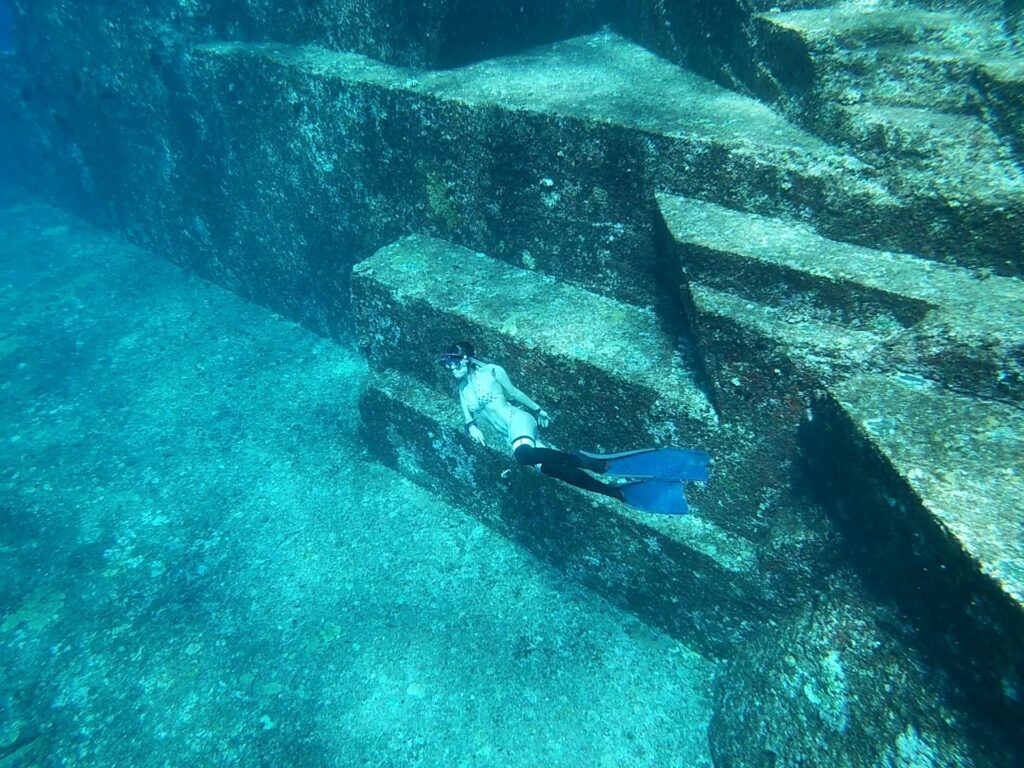
The article from the University of the Ryukyus outlines several key points supporting the idea that the Yonaguni Monument is a natural formation rather than a man-made structure. Here are the main arguments:
Geological Composition:
The monument is primarily made of sandstone, a sedimentary rock commonly formed through layering and compression over thousands of years. The erosion patterns and textures observed on the monument align with those seen in naturally weathered sandstone formations.
Formation Processes:
Both Kimura’s research and other geological analyses point out that the monument’s terraces, steps, and sharp edges could result from natural erosion due to ocean currents, tectonic activity, and wave action. These forces can create straight lines and angular shapes that might resemble man-made structures.
Comparison with Other Natural Formations:
The monument shares characteristics with other large, naturally occurring underwater formations found globally. Kimura’s team, while acknowledging the monument’s unique appearance, highlights similar formations created by natural geological processes rather than human intervention.
Scientific Studies and Survey Evidence:
Various geological surveys conducted in Yonaguni and surrounding areas have gathered data through underwater mapping and imaging, which support a natural origin for the monument. Detailed mapping techniques, including sonar and underwater television robots, have provided clear images of the monument that align more closely with natural rock formations than human-made structures.
Skepticism Towards Human Intervention:
While Kimura’s research raises interesting possibilities, there is a degree of skepticism regarding human involvement in constructing the monument. The geological features attributed to human design can largely be explained through natural erosion and the geological activity of the area.
For a deeper understanding and further details, you can read the full article here.
Why the Mystery about the Underwater Ruins continues
One thing is for certain: nobody really wants to find out whether it is natural or man-made as this diving site is attracting a large number of divers in Japan and around the world. Indeed, it is one of the most popular diving sites in Japan. And one of the reasons for its popularity is definitely the mystery to its origin.
We want to keep debating and wondering whether it is man-made or natural. Well, that is what keeps bringing people, right? It has to stay mysterious.
In any case, there is no point of debating whether it is man-made or natural if you’d never visit the monument. Now let me show you in detail how best to plan your visit to the Yonaguni Monument.
The Best Time to Visit the Yonaguni Monument
Planning a trip to the Yonaguni Monument involves more than just packing your diving gear. The unpredictable weather patterns of this remote island can significantly impact your experience and schedule. While many might think summer is the ideal time to visit, this is a major pitfall. The best time to visit the Yonaguni Monument for diving and exploring is actually during the fall and spring months.
Let’s dive into the specifics of when to visit, taking into account the unique challenges and opportunities each season offers.
Avoid Summer: The South Wind Challenge
Contrary to popular belief, summer is not the ideal time to visit the Yonaguni Monument. Here’s why:
- South Wind Issues: Strong south winds are common during the summer, particularly in June, July, and August.
- Boat Travel: These winds make it difficult to reach the monument from Kubura Port, as the journey can be lengthy and choppy.
- Diving Conditions: The strong waves caused by the south wind can create unfavorable diving conditions.
As you can see, Yonaguni Monument is located in the southeast portion of the island. That means it is going to be hard for a boat to get there from Kubura port with the south wind and too far from Sonai port.
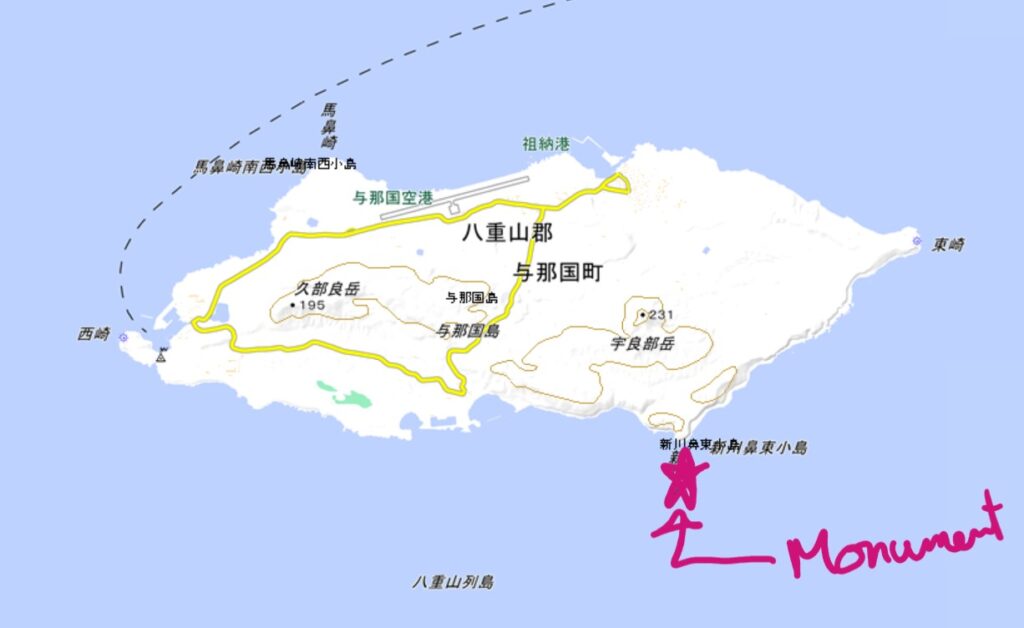
And even if you manage to get there, the waves from south will be hitting the Monument site that it makes far from ideal for divers and snorkelers to calmly observe the Monument.
Fall: The Ideal Time for Visibility
The best time to visit the Yonaguni Monument for diving and snorkeling is between September and November.
Calm Waters: The winds typically shift to a more favorable direction during the fall, providing calmer waters and better visibility for underwater exploration.
The chance of getting to the Yonaguni Monument site increases when the wind blows from the north (not too hard though). That means you’d better visit there sometime between September and November.
Winter and Spring: For Hammerhead Shark Encounters
the alternative will be the full winter and early spring.
For experienced divers seeking a unique underwater adventure, the full winter and early spring months offer a chance to encounter hammerhead sharks.
- Shark Diving: All four diving centers in Yonaguni allow diving for hammerhead sharks from December to early April.
- Limited Monument Access: During this season, the focus may be on shark diving, so access to the monument may be limited.
I can recommend going there for the Yonaguni Monument in the winter only if you are a drift diver who enjoy diving with Hammerhead Sharks. You must be aware that all four diving centers in Yonaguni let you dive only if you are going for shark diving from December to early April.
Even then, going to the Yonaguni Structure is not guaranteed during the winter season as most diving centers give priority to showing hammerheads to the divers.
Early May: A Possible Alternative
May could be another alternative as the temperature is still not extremely high, and the highest season for Yonaguni is just over after the Golden Week.
- Pleasant Temperatures: May offers pleasant temperatures.
- Fewer Crowds: The peak tourist season is usually over after Golden Week.
- “Ka-chibai” Winds: However, strong south winds called “Ka-chibai” can occur in late May.
The only concerning element is that you might encounter the strong south wind called “Ka-chibai” in late May, then you are surely not visiting the Yonaguni Structure.
May can be a good option if you can’t visit during the fall or winter months.
Remember:
- Monitor Weather Conditions: Always check the weather forecast before your trip.
- Book Your Diving Tours Early: Dive tours are popular, so book them in advance.
Exploring the Monument: Diving and Snorkeling
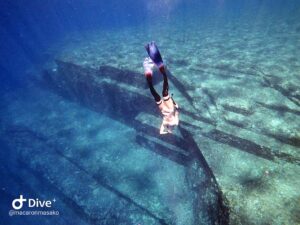
To dive or snorkel… that is the question you need to ask when deciding how you are going to make your monument visit come true.
First, you need to decide whether you want to see the monument by snorkeling or by scuba diving. I’d personally recommend doing both. Once with scuba gears and once without. Here is why.
Scuba Diving: A Deeper Dive
The Yonaguni Monument offers a truly unique underwater experience for scuba divers. Dive through the small tunnel-like entry gate (城門 ぐすくもん), at about 15 meters deep, and explore the intricate structures of the monument from a closer perspective. The monument’s sheer size and complexity offer a thrilling and unforgettable underwater adventure.
Snorkeling: A Surface Perspective
For those who prefer to stay above the water, snorkeling provides a breathtaking view of the entire monument. You can observe the monument’s terraced formations, sharp edges, and its massive scale from the surface. The clear waters around Yonaguni Island offer excellent visibility for snorkeling.
Both views are amazing, and they give you different emotions you can enjoy only being immersed there. Why not try both ways, if you are there anyway.
Don’t Miss These Landmarks
There are several well-known spots within the Yonaguni Monument dive site.
- The Tunnel-Like Entry Gate (城門 ぐすくもん): This narrow passageway is a popular spot for scuba divers, leading to a central chamber within the monument. The gate is a stunning example of the monument’s intricate features.
- The Main Terraced Structures and Platforms: These stepped formations are some of the most striking features of the Yonaguni Monument. The precision of the terraces and platforms has fueled speculation about their origins.”
- The Turtle Rock Formation: This intriguing formation, resembling a turtle sen from above, adds to the mystique of the Yonaguni Monument. Divers and snorkelers often take photos of this unique landmark.”
How to Plan your visit to the Underwater Ruins in Yonaguni
You made a choice between diving and snorkeling and now you want to really get to the organizing part. Here are some tips on how to book your visit to the underwater ruins in Yonaguni.
Secure Your Accommodation First!
Yonaguni Island is known to have a very limited capacity for accommodation. There is no hotel. There are guesthouses, Minshuku (small bed and breakfast) and Airbnb. Many places do not allow internet booking either, so your choices are even limited. Book your accommodation first. That is my best advise.
Booking Your Diving Trip to the Yonaguni Monument
You can book with any of four diving centers in the Yonaguni Island to scuba dive at the Yonaguni Monument.
If you’re planning a diving trip, you can choose from any of the four diving centers on Yonaguni Island. They offer various diving packages, from beginner-friendly excursions to more advanced dives.
It is important to request to visit Yonaguni Monument. Don’t forget to mention the monument multiple times.
If you prefer a personalized experience, consider contacting me to arrange for a translator guide. I’ll accompany you throughout your trip, providing valuable insights and guidance
Glass Boat Tours: An Alternative View
If you don’t want to bother getting into water at all, you can go there on a glass boat tour organized by Sow Wes.
For those who prefer to stay dry, a glass boat tour offers an excellent alternative to diving. You can admire the Yonaguni Monument from above, enjoying a unique perspective on its massive scale and structure. Sow Wes offers glass boat tours from Kubura Port
Let me know what you thought of the Yonaguni Momument once you managed to visit there. In your opinion, is it a man-made or a natural rock formation?
Travel Essentials: What to Pack for Yonaguni
You can rent all your water sport equipment. You don’t need to worry about forgetting some diving equipment, but here is something you do not want to forget.
there is no supermarket or drugstore in Yonaguni. That means you need to bring all your necessities with you.
Medications: Ensure you have all your necessary prescriptions and over-the-counter medications.
Cosmetics: Bring any essential toiletries and cosmetics, as there are no drugstores on the island.
Swimsuit: Pack your swimsuit for diving and snorkeling.
Shoes: Bring sandals, flip-flops, or waterproof shoes for exploring the island.
Conclusion
Planning your visit to the Yonaguni Monument is an exciting adventure. Whether you choose to dive, snorkel, or explore from a glass-bottom boat, you’re guaranteed a unique experience. Remember to secure your accommodation in advance, and don’t forget to embrace the island’s mystery and natural beauty.
FAQ about Yonaguni Monument
Q: How do I get to Yonaguni Island?
A: The best way to reach Yonaguni Island is by flying to Ishigaki Island and then taking another flight with RAC to Yonaguni.
Q: What is the best time of year to visit?
A: The best time to visit is during the fall (September-November) for calm seas and excellent visibility. Winter (December-April) is a good time for hammerhead shark encounters, but the monument might not be a primary focus during this season.
Q: How long should I stay on Yonaguni Island?
A: Most visitors stay for at least 3-4 days to fully explore the island and the Yonaguni Monument. But 1 week is highly recommended to increase your luck with favorable weather to go to the monument.
Q: What language is spoken on Yonaguni Island?
A: The primary language spoken on Yonaguni Island is Japanese. However, some dive shop staff members speak some English.
Q: Are there any other attractions on Yonaguni Island?
A: Yonaguni Island boasts stunning natural beauty, from its pristine beaches and rugged cliffs to its unique wildlife, including wild horses and cows. Explore the island’s hiking trails, where you can discover breathtaking views and hidden coves. Indulge in the local cuisine, featuring fresh seafood caught daily, and immerse yourself in the island’s rich culture. Discover the traditional arts, crafts, and music that make Yonaguni Island a truly unique destination.
